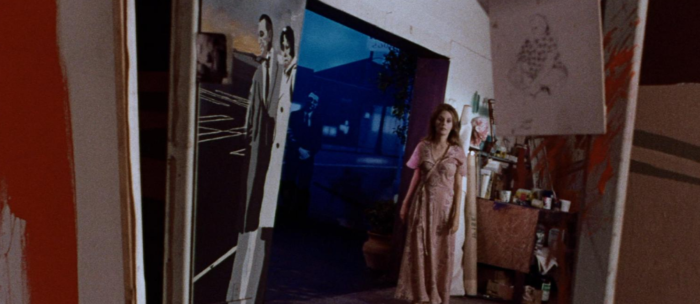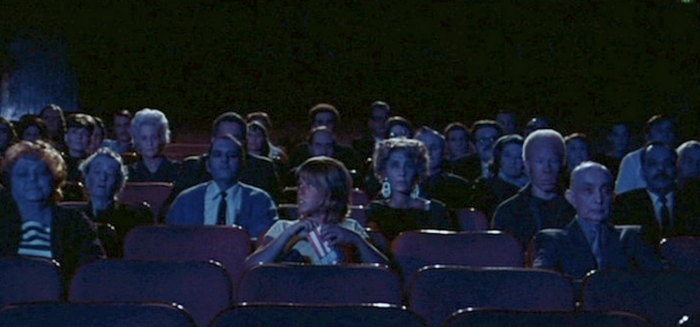
I chose Messiah of Evil as my first entry for this year’s Shocktober for the talent involved. I’m referring to husband and wife writing/directing team Willard Huyck and Gloria Katz. The pair is best known for co-writing American Graffiti with George Lucas. They were also the screenwriters behind Indiana Jones and the Temple of Doom and surprisingly, were script doctors on the original Star Wars. It’s believed that Huyck and Katz were responsible for fixing most of Leia’s dialogue and making her a more comedic character. They also wrote and directed Howard the Duck. Though we do not speak of such evil on this website.
Considering the amount of George Lucas collaborations, I figured Messiah of Evil must share some DNA with those other projects. This is a clever team of storytellers, they must have this Hollywood thing down to a science, right? What I didn’t take into consideration is that Messiah of Evil was made right before Huyck and Katz become Hollywood players with American Graffiti. This isn’t an A-list Hollywood flick. Quite the contrary, this is a weird Avant-garde descent into madness. I’m not gonna lie, I didn’t love the film but I respect the hell out of it.
Messiah of Evil follows a young woman named Arletty (Marianna Hill) as she travels to the lonely beach town of Point Dume, California. She’s searching for her father, an artist who she’s been estranged from, and descends into a rabbit hole of weirdness once she realizes he’s missing.
The film is a deliberately paced mystery with enough voice-over to make you feel like you’re watching a noir. Though I’m sure this is mostly done to cut back on sound recording costs. Then again, it does provide a cerebral feel to the film. Arletty befriends an aristocrat Thom (Michael Greer) and his two companions, Toni (Joy Bang) and Laura (Anitra Ford) as they explore and learn about the town. A local eccentric played by Elisha Cook Jr. tells them that many people in the town are followers of a “dark stranger” or “messiah” who will return on the next blood moon.
So the film is kind of a cult film but it’s also kind of a vampire movie. Though the ghoulish occupants of Point Dume feel more like zombies, with pale skin and the kind of clothes you’d see at a funeral. As we draw closer to the Blood Moon, Arletty and her friends are picked off by the vampires in some surprisingly effective sequences. There’s one where Laura wanders through an empty supermarket where she comes upon a group of vampires chowing down on raw meat, only to chase her. There’s also a memorable sequence where Toni goes to the movies. She’s by herself and then quickly vampires start filling seats in the auditorium until they eventually turn on her.
The horror elements in Messiah of Evil are very effective. Where the film drags is everything in-between those sequences. There’s a stoner-y kind of pace to the rest of the film. Very student film. The characters aren’t particularly memorable, aside from a rat-eating Albino truck driver played by Bennie Robinson. The acting is good but the emotional drive feels flat. I never really cared if Arletty found her father or if anyone lived for that matter.
The film reminds me a lot of Herk Harvey’s 1962 indie horror classic Carnival of Souls. Both are low-budget set in desolate locations with zombie-like villains. I actually wouldn’t mind seeing Messiah of Evil added to the Criterion Collection as well. The film deserves a more polished version (though the one I watched on Shudder was fine) and it certainly has enough artistic merit to join the Criterion ranks.
I should also note this film was so close to becoming a lost film. According to actress Anitra Ford in a 2011 interview:
“Shot in 1971, this movie was originally titled ‘The Second Coming’. Towards the end of the filming, investors pulled their money out, and the film was never finished. A Frenchman bought the unedited footage, edited it, and released the movie under the title of ‘Messiah of Evil’.”
The film has continued to have an odd history of being re-released over the years under multiple different titles including “Return of the Living Dead” with an advertising campaign that used images from various Romero works (which led to a lawsuit) and “Dead People” in 1983. The notoriety of Huyck and Katz has kept the film’s legacy alive but even if this film had been made by a nobody who had disappeared it’s worth watching. It’s got hippies, it’s got vampires, it’s got bugs. This is a real skin-crawler.
Pictured Above: Gloria Katz working with ‘ol Georgie Porgie himself.




